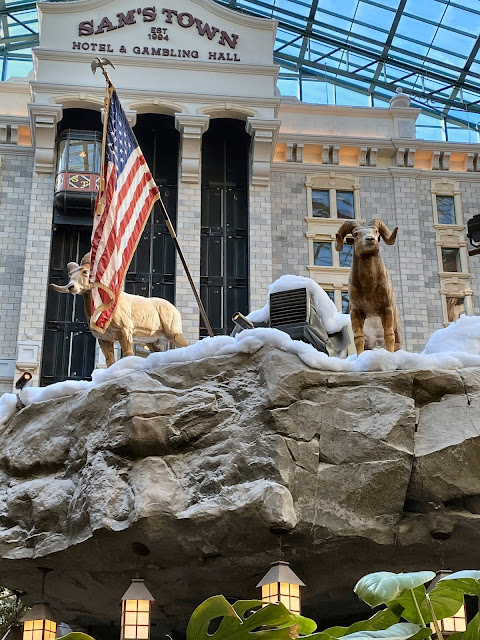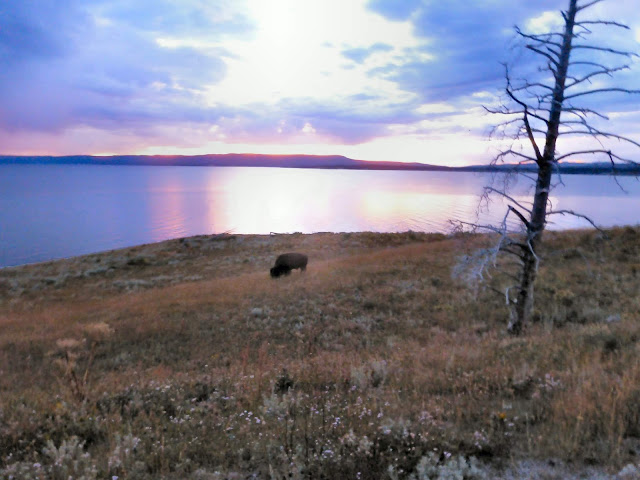Christmas in Las Vegas and San Diego Safari Park
Winter 2019
We drive to Las Vegas at least twice a year, so we have a travel routine that works well for us. Part of the plan is to make a pit stop at the Exxon station in Amargosa Valley.
We'll have to change our plans for the future because the gas station is gone. I know businesses close on a regular basis, but this place was literally gone---only a vacant lot was left.
We've seen stranger things near Area 51 before, including dead and mutilated cattle, but this is the first time anything has vanished on us. I'm not sure it qualifies as a Close Encounter of the 2nd Kind or not, but it really did seem that someone had packed up everything and left for parts unknown.
Fortunately, there are some things you can count on and Las Vegas is one of them. The Bellagio Conservatory had its annual Christmas display as did Ethel M. Chocolates. Even the Venetian had its holiday version of Carnivale de Venezia with opera singers, stilt-walkers, and living statues.
 |
| The Bellagio Display Has Been Changed-Up A Bit This Year |
 | |||
| Ethel M. Cactus Garden |
 |
| Carnivale de Venezia - Renaissance Players at Venetian Hotel |
 |
| Living Statue at St. Mark's Square, Venetian Hotel |
We also visited Sam's Town to see the Christmas version of its center-hall Mystic Falls. We first visited there in the mid-1970s and it hasn't changed very much since then.
 | |||
| Sam's Town |
 |
| Mystic Falls Area Decorated for Christmas |
On a different note, the National Atomic Testing Museum is so comprehensive in its scope that a one-day visit isn't nearly enough. The museum showcases the actual history, the government propaganda, and the deep controversies that surround atomic power.
There was no attempt to whitewash anything. As one example, there were multimedia displays that ranged from "Duck and Cover" videos to anti-nuclear demonstrations to scenes from Dr. Strangelove.
The historical exhibits regarding nuclear weapons begin with the Manhattan Project's Trinity nuclear test and lead up to the current efforts at the Nevada Test Site to ensure the viability of our nuclear weapons while not being able to perform actual tests of the devices themselves.
The high quality of all of the presentations reminded me of the Manzanar exhibits which I consider the best I've ever seen. But what really caught my eye and made me laugh was the re-creation of the first Director's office. The desk, chair, and filing cabinet are from 1951, but these were still standard military issue 20 years later when I was at March AFB and I would have been quite at home sitting there.
 |
| Re-creation of Director's Office, Nevada Test Site |
_ _ _
Of course, we also made a visit to the Lake Mead National Recreation Area to check on the Hoover Dam and the current depth of the lake.
While we were driving out to the dam, we observed the mother of all speed traps.
On the opposite side of the freeway, we saw four motorcycle highway patrolmen with vehicles pulled off to the side. This was notable in itself, but as we drove further down the highway, we saw a dozen more motorcycles and other patrol vehicles sitting on the on-ramp, each waiting their turn to hunt down their prey. I've never seen anything quite like it before. From our side of the road it was an amusing sight, but I don't think everyone felt that way.
Obviously, we didn't see any patrol vehicles for the rest of our drive, but what we found when we got there was a slightly more disconcerting.
This past summer, we saw huge amounts of water being released through Flaming Gorge, but it seems they're keeping it all in Lake Powell because Lake Mead is being held at just the bare minimum depth that allows the power turbines to keep operating. It makes for a very sad sight.
 |
| Lake Mead - Most of These Islands Should Be Underwater |
_ _ _
From Las Vegas, we headed southwest to San Diego county to visit the San Diego Zoo Safari Park. The last time we visited was in 1972 when it first opened as the Wild Animal Park. The name change is only the least of the differences.
The major change is that when we visited in 1972, we walked through a small African village area and quickly boarded the tram. Now, it's a 15 minute walk through an extensive number of exhibits before you take an elevator down to the African plains and the tram. Another difference is that this African landscape is extremely lush compared to the unfinished environment we saw then, with the animals gathering around the feeding areas and water troughs.
 |
| Wild Animal Park in 1972 |
 |
| Gorilla Family |
 |
| Cheetah |
_ _ _
We had a great day there and we gave it our all, but we ran out of time and energy and will have to return to visit the Australian Outback to see kangaroos and platypuses and then walk the Tiger Trail to see the tigers on the Asian Savanna.
_ _ _
We headed back to Reno just ahead of a storm that promised flooding in the basin and snow in the passes, but we took time to drive through Riverside for a quick stop at the California Citrus State Historic Park where we were able to get bags of navel oranges and grapefruit from the Gless Ranch citrus stand. Gless Ranch was the first in California to sell oranges from a roadside stand and, today, they maintain the citrus trees at the state park.
 |
| Gless Ranch Roadside Citrus Stand |
I wasn't nearly as nonchalant and we quickly got back on the road and soon found the reason for their unconcern: the road was clear up to Mammoth, but five miles later the snow was accumulating and those without snow tires were pulling over to put on chains.
We stayed at the front of the storm and the rest of the ride home was uneventful.
_ _ _
For More Pictures, Go To: Christmas 2019





















































